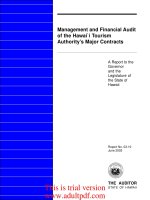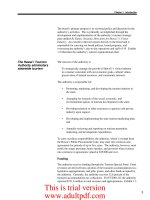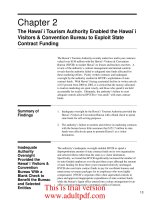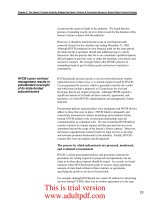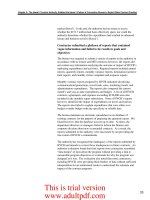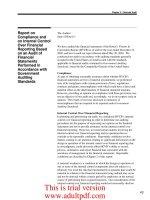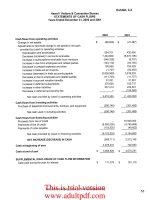Management and Financial Audit of the Hawaii Tourism Authority’s Major Contracts A Report _part6 ppt
Bạn đang xem bản rút gọn của tài liệu. Xem và tải ngay bản đầy đủ của tài liệu tại đây (259.99 KB, 10 trang )
43
Chapter 3: Financial Audit
The Auditor
State of Hawai`i:
We have audited the financial statements of the Hawai`i Visitors &
Convention Bureau (HVCB) as of and for the year ended December 31,
2002, and have issued our report thereon dated May 20, 2003. We
conducted our audit in accordance with auditing standards generally
accepted in the United States of America and with the standards
applicable to financial audits contained in Government Auditing
Standards, issued by the Comptroller General of the United States.
Compliance
As part of obtaining reasonable assurance about whether HVCB’s
financial statements are free of material misstatement, we performed
tests of its compliance with certain provisions of laws, regulations,
contracts and grants, noncompliance with which could have a direct and
material effect on the determination of financial statement amounts.
However, providing an opinion on compliance with those provisions was
not an objective of our audit and, accordingly, we do not express such an
opinion. The results of our tests disclosed no instances of
noncompliance that are required to be reported under Government
Auditing Standards.
Internal Control Over Financial Reporting
In planning and performing our audit, we considered HVCB’s internal
control over financial reporting in order to determine our auditing
procedures for the purpose of expressing our opinion on the financial
statements and not to provide assurance on the internal control over
financial reporting. However, we noted certain matters involving the
internal control over financial reporting and its operation that we
consider to be reportable conditions. Reportable conditions involve
matters coming to our attention relating to significant deficiencies in the
design or operation of the internal control over financial reporting that,
in our judgment, could adversely affect HCVB’s ability to record,
process, summarize, and report financial data consistent with the
assertions of management in the financial statements. Reportable
conditions are described in Chapter 2 of this report.
A material weakness is a condition in which the design or operation of
one or more of the internal control components does not reduce to a
relatively low level the risk that misstatements in amounts that would be
material in relation to the financial statements being audited may occur
and not be detected within a timely period by employees in the normal
course of performing their assigned functions. Our consideration of the
internal control over financial reporting would not necessarily disclose
Report on
Compliance and
on Internal Control
Over Financial
Reporting Based
on an Audit of
Financial
Statements
Performed in
Accordance with
Government
Auditing
Standards
This is trial version
www.adultpdf.com
44
Chapter 3: Financial Audit
all matters in the internal control that might be reportable conditions and,
accordingly, would not necessarily disclose all reportable conditions that
are also considered to be material weaknesses. However, we believe that
none of the reportable conditions described above is a material
weakness.
This report is intended solely for the information and use of the Auditor,
State of Hawai`i and the board of directors and management of the
Hawai`i Tourism Authority and HVCB and is not intended to be and
should not be used by anyone other than these specified parties.
/s/ Nishihama & Kishida, CPA's, Inc.
Honolulu, Hawai`i
May 20, 2003
The following is a brief description of the financial statements audited by
Nishihama & Kishida, CPA's, Inc., which are presented at the end of this
chapter.
These statements present the assets, liabilities, and net assets of HVCB
at December 31, 2002 and 2001.
These statements present the revenues, expenses and changes in net
assets of HVCB for the years ended December 31, 2002 and 2001.
These statements present the cash flows from operating, investing, and
financing activities of HVCB for the years ended December 31, 2002
and 2001.
This unaudited schedule presents the types and amounts of in-kind
contributions received by HVCB during the years ended December 31,
2002 and 2001.
Explanatory notes that are pertinent to an understanding of the financial
statements and financial condition of HVCB are discussed in this
section.
Description of
Financial
Statements
Statements of Financial
Position (Exhibit 3.1)
Statements of
Activities (Exhibit 3.2)
Statements of Cash
Flows (Exhibit 3.3)
In-Kind Contributions
at Fair Value (Exhibit
3.4)
Notes to Financial
Statements
This is trial version
www.adultpdf.com
45
Chapter 3: Financial Audit
The Hawai`i Visitors & Convention Bureau (HVCB), a nonprofit
corporation, can trace its origins back to 1892 when business leaders
formed the Hawaiian Bureau of Information. That group was disbanded
and another was formed in 1902 as a joint committee of the Chamber of
Commerce of Honolulu and the Merchants Association. In 1903, the
Territorial Legislature recognized the importance of tourism marketing
by funding the committee’s work. In 1945, the tourism marketing
organization became known as the Hawai`i Visitors Bureau. In April
1959, the bureau was incorporated under the laws of the State of Hawai`i
(State) for the primary purpose of promoting travel to and among the
Hawaiian Islands. In July 1996, the name was officially changed to the
Hawai`i Visitors & Convention Bureau.
HVCB’s primary source of state funds is derived from contracts with the
Hawai`i Tourism Authority (authority). Other revenues are derived
primarily from subscription income (e.g., private sector income) from
members primarily domiciled in the state, and from cooperative
marketing programs.
The accompanying financial statements include the marketing activities
and resources of island chapters of HVCB that are funded under
HVCB’s agreement with the authority.
(a) Financial statement presentation
Net assets, revenues and expenses are classified based on the existence
or absence of donor-imposed restrictions. Accordingly, net assets of
HVCB and changes therein are classified and reported as follows:
Unrestricted Net Assets - Net assets not subject to donor-imposed
stipulations.
Temporarily Restricted Net Assets - Net assets subject to donor-imposed
stipulations that may or will be met either by actions of the HVCB and/
or the passage of time.
(b) Cash equivalents
For purposes of the statements of cash flows, HVCB considers all
instruments with original maturities of three months or less to be cash
equivalents.
(c) Revenue recognition - State appropriations
State appropriations revenue is recognized when the related expenditures
are incurred.
Note (1) - Description
of Business
Note (2) - Summary of
Significant Accounting
Policies
This is trial version
www.adultpdf.com
46
Chapter 3: Financial Audit
(d) Depreciation and amortization
Leasehold improvements are amortized over the respective lease terms
(two through eleven years). Furniture and equipment are depreciated
using the straight-line method over their estimated useful lives of three to
seven years. The image library is depreciated using the straight-line
method over its estimated useful life of five years. The mall tour stage
and automobile are depreciated using the straight-line method over their
estimated useful lives of three years.
(e) Use of estimates
The preparation of the financial statements requires HVCB management
to make a number of estimates and assumptions relating to the reported
amounts of assets and liabilities and the disclosure of contingent assets
and liabilities at the date of the financial statements and the reported
amounts of revenues and expenses during the period. Significant items
subject to such estimates and assumptions include the carrying amount of
leasehold improvements, furniture, and equipment; and the valuation
allowances for receivables. Actual results could differ from those
estimates.
HVCB had a noncontributory defined benefit pension plan that covered
all full-time employees who had attained the age of 21 and had
completed one year of service. Participants in the plan were eligible for
normal retirement benefits when they reached age 65. The normal
retirement benefit was a percentage for each year of service based on the
average final compensation and the social security covered
compensation. Participants were fully vested in their accrued benefits
under the plan after completing five years of eligible service. HVCB’s
funding policy was to fund contributions that were actuarially
determined as necessary to fund the cost of the plan subject to minimum
funding standards as required by the Employee Retirement Income
Security Act of 1974. The plan had been curtailed and benefits under the
pension plan were frozen as of December 31, 1996. The plan was
terminated on July 31, 2000 and all liabilities were settled.
HVCB has a deferred compensation plan under Section 401(k) of the
Internal Revenue Code for substantially all regular employees.
Participants of the plan may contribute up to 15 percent of their pre-tax
salary, or $11,000, whichever is less. The plan provides for matching
contributions to be determined by the employer each year. For the years
ended December 31, 2002 and 2001, HVCB matched 100 percent of
each dollar contributed up to the first $2,000 for each participant’s
contribution. Matching contributions amounted to $140,438 and
$125,371 for the years ended December 31, 2002 and 2001, respectively.
Note (3) - Retirement
Plan
This is trial version
www.adultpdf.com
47
Chapter 3: Financial Audit
All qualified matching contributions, employee contributions, and
rollovers or transfer contributions are 100 percent vested. All other
contributions vest under the following schedule:
A summary of leasehold improvements, furniture, and equipment at
December 31, 2002 and 2001 follows:
2002 2001
Leashold improvements $ 826,672 $ 820,110
Furniture and equipment 1,805,071 1,514,887
Automobile 20,911 20,911
2,652,654 2,355,908
Less accumulated depreciation and amortization 1,639,571 1,084,870
$ 1,013,083 $ 1,271,038
HVCB had a $10,000,000 participative short-term line of credit with two
commercial banks that matured on December 31, 2002. The short-term
line of credit was secured by accounts receivable from the authority.
Interest was payable monthly at 0.25 percent above the bank’s base rate
(4.75 percent at December 31, 2001) and the principal balance and all
accrued interest were due at maturity. Outstanding borrowings under
this line of credit amounted to nil and $6,000,000 at December 31, 2002
and 2001, respectively. The line of credit was extended through June 30,
2003, with interest payable monthly at the bank’s base rate.
HVCB had a note payable in the amount of $313,810, which provided
for interest at 0.75 percent above the bank’s base rate and was payable in
monthly installments of $14,445, including interest. All principal and
accrued interest on the loan was due on or before May 17, 2002. The
note was secured by certificates of deposits, subscriptions receivable,
certain furniture and equipment, and various other assets. The
outstanding balance of this note payable at December 31, 2001 was
$57,026. The note payable was paid off during 2002.
Note (4) - Leasehold
Improvements,
Furniture, and
Equipment
Note (5) - Short-term
Line of Credit
Note (6) - Notes
Payable
Vested
Years of credit service percentage
Less than one year None
Two years 20%
Three years 40%
Four years 60%
Five years 80%
Six years or more 100%
This is trial version
www.adultpdf.com
48
Chapter 3: Financial Audit
On August 10, 2001, HVCB obtained a note payable in the amount of
$125,000, which provides for interest at the bank’s base rate minus 0.25
percent (4.00 percent and 4.50 percent at December 31, 2002 and 2001,
respectively) and is payable in monthly installments of $3,900, including
interest. All principal and accrued interest on the loan is due on or
before August 10, 2004. At December 31, 2002, approximate maturities
of the note payable amounted to $41,195 in 2003 and $23,913 in 2004.
The note payable is secured by a security interest in the Global Trade
Show Pavilion. The note payable amounted to $65,108 and $111,602 at
December 31, 2002 and 2001, respectively.
No provisions for income taxes have been made as the Internal Revenue
Service has granted HVCB an exemption from normal income taxes
under Section 501(c)(6) of the Internal Revenue Code.
HVCB occupies certain premises under leases that expire on various
dates through 2011. Total rent expense for the years ended December
31, 2002 and 2001 was $1,005,381 and $866,617, respectively.
Future minimum lease payments under operating leases as of December
31, 2002 are as follows:
Substantially all leases included above provide that HVCB pay taxes,
maintenance, insurance, and certain other operating expenses applicable
to the leased premises.
It is expected that in the normal course of business, leases that expire
will be renewed or replaced by other leases. Any additional future lease
rental commitments that may arise from renewals or renegotiations
cannot be determined at this time; however, most renewal options
provide that the minimum lease rental for the renewal period shall not be
less than the minimum lease rental for the preceding period.
Note (7) - Income Taxes
Note (8) - Lease
Year Ending December 31, Amount
2003 $ 667,163
2004 508,405
2005 410,877
2006 341,913
2007 327,139
Thereafter 895,961
Total future minimum lease payments $ 3,151,458
This is trial version
www.adultpdf.com
49
Chapter 3: Financial Audit
The temporarily restricted net assets represents moneys received from
the people of Hawaii as a direct response to a tour bus-hijacking
incident. All designated moneys collected and interest earned thereon
are to remain with HVCB to aid visitors who are victims of crime.
HVCB has various amounts due to and from employees and related
parties including affiliated offices on the neighbor islands. At December
31, 2002 and 2001, due from related parties is comprised of the
following:
Due to employees, primarily for expense reimbursements, and related
parties are comprised of the following at December 31, 2002 and 2001:
In-kind contributions consist primarily of donated publications, hotel and
meeting rooms, airline tickets, and rental cars and ground transportation.
The estimated fair value of these donations were $5,501,999 and
$6,145,427 for the years ended December 31, 2002 and 2001,
respectively, and are reflected as revenues and expenses in the
accompanying statements of activities.
HVCB is involved in litigation over a contract dispute with a vendor. In
the opinion of management, although the outcome of any legal
proceedings cannot be predicted with certainty, the ultimate liability of
HVCB in connection with the legal proceedings will not have a material
adverse effect on HVCB’s financial position, change in net assets, or
cash flows.
Due to legislation passed in 2002 and effective January 1, 2003, the
responsibilities of marketing the Hawai`i Convention Center (HCC) were
Note (9) - Temporarily
Restricted Net Assets
Note (10) - Related
Party Transactions
2002 2001
Island chapters $ 402,532 $ 281,483
Employees 2,201
78
$ 404,733 $ 281,561
2002 2001
Island chapters $ 463,756 $ 561,587
Employees 140,313
154,182
$ 604,069 $ 715,769
Note (11) - In-Kind
Contributions
Note (12) - Litigation
Note (13) - Termination
Benefits
This is trial version
www.adultpdf.com
50
Chapter 3: Financial Audit
transferred from the HVCB to SMG, the management company
responsible for the operations of the HCC. As a direct result of this
legislation, HVCB terminated the HCC marketing group that was a part
of its meetings, conventions, and incentives department in December
2002. Severance pay related to this termination was accrued as of
December 31, 2002 and are to be paid throughout 2003.
This is trial version
www.adultpdf.com
This is trial version
www.adultpdf.com
This is trial version
www.adultpdf.com
